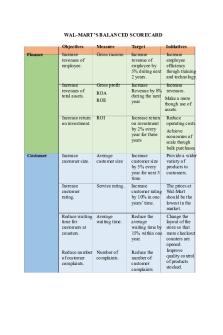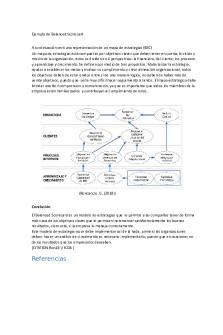Balanced Scorecard essay (2,000 words) PDF

| Title | Balanced Scorecard essay (2,000 words) |
|---|---|
| Author | Taha Bakhsh |
| Course | Management Accounting and Control |
| Institution | Cardiff University |
| Pages | 10 |
| File Size | 90.2 KB |
| File Type | |
| Total Downloads | 90 |
| Total Views | 153 |
Summary
Essay about the balanced scorecard discussing pros and cons as a management tool. It uses relevant literature and assesses issues in implementation....
Description
1442221$
BS3517$
1946$Words$
“Drawing) on) relevant) literature) critically) evaluate) the) Balanced) Scorecard) (BSC)) as) a) performance) measurement) and) management) control) tool)and)discuss) the) various) issues) that) organizations) must) consider) when) developing) and) implementing) a) Balanced) Scorecard.”)
The$ Balanced$ Scorecard$ (BSC),$ a$ management$ accounting$ tool$ developed$ by$ Kaplan$ and$ Norton$(1992),$lead$to$several$changes$in$management$practice$by$introducing$a$practicable$ way$ to$ integrate$ non-financial$ and$ financial$ performance$ measures.$ The$ BSC$ divides$ organisational$objectives$into$four$main$perspectives,$financial,$customer,$internal$process,$ and$learning$and$growth$perspectives,$allowing$managers$to$set$financial$and$non-financial$ targets$which$are$expected$to$result$in$long$term$benefit$to$the$organisation.$The$goals$are$ measured$ independently,$ but$ succeeding$ in$ one$ perspective$ is$ expected$ to$ lead$ the$ organisation$closer$to$achieving$its$other$objectives,$known$as$cause$and$effect.$Due$to$its$ ability$to$facilitate$the$integration$of$ non-financial$objectives$into$a$holistic$strategy,$its$use$ has$become$widespread$(Awadallah$and$Allam$2015),$and$it$could$be$described$as$an$essential$ tool$when$moving$from$traditional$to$strategic$management$accounting$(Kaplan$and$Norton$ 1996a).$Despite$its$popularity,$critics$argue$that$the$BSC$is$not$as$effective$as$managements$ might$believe,$that$it$lacks$backing$from$scientific$evidence$and$that$it$is$difficult$to$implement$ for$entities,$especially$due$to$the$possibly$vague$nature$of$the$cause-and-effect$relationship$ upon$which$the$BSC$lies.$This$essay$will$critically$evaluate$the$BSC$as$a$management$tool,$in$ its$effectiveness$for$both$performance$measurement$and$management$control,$as$well$as$the$ theoretical$ and$ practical$ issues$ that$ may$ arise$ for$ an$ organisation$ when$ developing$ and$ implementing$a$BSC.$
$
1
1442221$
BS3517$
1946$Words$
According$to$ Kaplan$ and$ Norton$ (1992;$ 1993),$the$ BSC,$ described$ as$ a$ long-term$ strategic$ tool,$ supplies$ managers$ with$ a$ framework$ to$ measure$ performance$ in$ more$ areas$ than$ traditionally$ considered.$ It$ allows$ managers$ to$ track$ an$ organisation’s$ progress$ towards$ performance$ drivers$ that$ are$ believed$ to$ allow$ for$ long-term$ growth,$ such$ as$ improving$ customer$relationships$ and$internal$ business$processes,$rather$ than$focusing$ on$periodical$ financial$ goals$ that$ may$ be$ short-term.$ It$ incorporates$ the$ four$ perspectives$ previously$ introduced$ in$ a$ hierarchy$ based$ on$ causal$ relationships,$ wherein$ to$ succeed$ financially,$ customer$ needs$ must$ be$ addressed,$ which$ would$ require$ changes$ in$ internal$ business$ processes$that$stem$from$learning$and$growth$(Kaplan$and$Norton$1992).$Therefore,$using$ the$ BSC$ for$ performance$ measurement$ allows$ managers$ to$ focus$ on$ long-term$ goals$ and$ motivate$ employees$ to$ work$ towards$ these$ objectives,$ towards$ intangible$ elements$ that$ could$ be$ considered$ more$ essential$ for$ long-term$ success$ than$ short$ term$ profits.$ When$ implementing$the$BSC,$the$managers$may$realise$previously$unclear$areas$of$weaknesses$that$ are$ causing$ losses$ for$ the$ organisation,$ through$ the$ causal$ relationship$ between$ the$ performance$ drivers$ (1996a).$ As$ a$ result,$ it$ provides$ a$ practical$ way$ to$ quantify,$ work$ towards,$and$measure$the$entity’s$success$in$achieving$non-financial$goals$that$could$lead$to$ the$success$of$the$company.$
Despite$ these$ merits,$ several$ critics$ highlight$ that$ the$ BSC$ suffers$ from$ severe$ conceptual$ deficiencies$ which$ may$ significantly$ limit$ its$ benefits$ to$ managers.$ There$ are$ several$ limitations$in$the$model$ concerning$ performance$ measurement$ that$might$ result$ in$ losing$ organisational$ focus$ rather$ than$ improving$ it.$ The$ most$ significant$ drawback$ could$ be$ the$ conceivably$ non-existent$causal$relationship$which$underpins$the$rationale$behind$the$four$ perspectives$ in$ the$ BSC.$ Several$ commentators$ show$ that$ there$ is$ in$ fact$ no$ causal$
$
2
1442221$
BS3517$
1946$Words$
relationship;$Norreklitt$ (2003)$ illustrate$ that$there$ is$ no$ statistical$ backing$to$ the$ assumed$ cause-and-effect$ between$ the$ different$ perspectives,$ stating$ that$ it$ may$ be$ theoretically$ sound$but$suffers$practical$deficiencies.$When$this$relationship$is$obscure,$the$BSC$might$not$ act$ as$ a$ successful$ performance$ measurement$ tool,$ since$ “good”$ performance$ might$ translate$to$poor$results$on$ill-calibrated$BSC$metrics.$This$way$the$targets$set$by$managers$ would$not$only$deviate$the$firm$from$long-term$success,$but$they$may$also$provide$a$faulty$ image$of$the$company’s$performance,$quite$possibly$hiding$its$weaknesses$(Norreklit$2003).$ Despite$this,$upon$further$analysis,$it$could$be$said$that$the$BSC$may$still$be$beneficial$to$use,$ if$the$individual$performance$measures$are$carefully$and$constructively$selected$to$ ensure$ there$ is$ some$ element$ of$ causation$ between$ them$ (Chytas$ et# al.$ 2011).$ Bukh$ and$ Malmi$ (2005)$see$the$scorecard$as$a$model$that$is$open$to$interpretation,$which$allows$for$specific,$ related$measures$to$be$used$to$create$the$causal$relationship$between$originally$unrelated$ perspectives.$This$could$explain$why$the$most$successful$firms$at$adopting$the$BSC$are$those$ who$tailor$it$to$their$needs$and$adjust$it$accordingly$(Epstein$and$Manzoni$1998;$Johanson$et# al.$ 2006).$ But$ drawing$ from$ this,$ a$ further$ limitation$ of$ the$ BSC$ could$ be$ the$ difficulty$ of$ selecting$the$appropriate$measures$for$performance,$which$Assiri$et#al.$(2006)$show$to$be$the$ most$significant$factor$in$the$BSC’s$successful$implementation.$
Moving$past$its$role$as$in$performance$measurement,$Kaplan$and$Norton$(1996a,$b)$hold$that$ the$BSC$can$also$act$as$a$strategic$management$tool,$by$allowing$managers$to$translate$longterm$vision$into$strategy.$In$addition$to$facilitating$the$inclusion$of$abstract$concepts$tan$gibly$ into$strategy,$Akkermans$and$Van$Oorschot$(2005)$show$that$the$creative$process$of$the$BSC$ urges$managers$to$think$about$factors$that$are$significant$under$the$four$perspectives$which$ might$have$previously$been$disregarded,$leading$to$value-adding$insight.$Furthermore,$ the$
$
3
1442221$
BS3517$
1946$Words$
essential$ function$ of$ management$ control,$ defined$ by$ Anthony$ (1965)$ is$ ensuring$ that$ resources$ are$ obtained$ and$ used$ effectively$ in$ order$ to$ achieve$ organisational$ objectives,$ which$ can$ be$ achieved$ using$ the$ BSC.$ Souissi$ and$ Itoh$ (2006)$ show$ how$ the$ BSC$ can$ be$ transformed$ into$ a$ management$ control$ tool,$ by$ managers$ using$ performance$ measure$ targets$ to$ communicate$ organisational$ strategy.$ Kaplan$ and$ Norton$ (1996a)$ show$ that$ ‘personal$ scorecards’$ relating$ to$ each$ team$ or$ individual$ can$ also$ be$ used,$ which$ show$ employees$exactly$how$their$work$fits$into$and$contributes$towards$the$overall$organisational$ strategy$in$each$of$the$four$perspectives.$They$support$that$it$can$help$managers$influence$ employee$behaviour$and$goal$congruence,$motivating$them$to$work$towards$clear$goals$that$ address$ intangible$ elements$ essential$ in$ an$ organisation’s$ long-term$ success$ (Kaplan$ and$ Norton$1996b).$
Exploring$ its$ limitations$ for$ management$ control,$ several$ academicians$ challenge$ the$ ‘balance’$on$the$BSC,$arguing$that$the$financial$perspective$is$not$prioritised$as$it$should$be$ (Noreklitt$ 2000)$ or$ that$ it$ has$ a$ too-high$ priority$ (Alexandra$ Albertsen$ and$ Lueg$ 2014).$ Johanson$et#al.$(2006)$add$that$priority$is$difficult$to$establish$between$the$perspectives$ due$ to$unclear$guidance,$especially$for$SMEs.$As$a$result,$managers$relying$on$the$BSC$might$not$ know$which$perspective$to$emphasise,$which$could$lead$to$ losing$focus$ among$lower$level$ employees$ rather$ than$ goal$ congruence.$ Furthermore,$ the$ BSC$ is$ not$ tied$ to$ reward$ incentives,$and$Alexandra$Albertsen$and$Lueg$(2014)$show$concerns$about$the$implication$of$ this$ on$ its$ ability$ to$ influence$ employee$ behaviour.$ While$ linking$ rewards$ to$ performance$ measurement$is$a$very$strongly$challenged$practice$(Hope$and$Fraser$2003),$there$are$still$ significant$implications$of$not$linking$the$BSC$to$reward$on$its$ability$to$influence$employee$ behaviour.$However,$the$arbitrary$and$non-scientific$nature$of$the$BSC’s$measures$mean$it$is$
$
4
1442221$
BS3517$
1946$Words$
a$poor$fit$for$compensation$(Epstein$and$Manzoni$1998),$justifying$why$Kaplan$and$Norton$ (1996a)$themselves$did$not$link$it$to$reward.$Yet,$several$studies$(Banker$et#al.$2000;$Davis$ and$Albright$2004)$show$that$when$employees$are$properly$educated$about$the$BSC$and$its$ causal$relationships,$they$are$motivated$to$work$towards$its$non-financial$measures,$which$ results$in$improved$financial$performance$and$triggered$rewards.$ As$a$result,$due$to$unclear$ priorities$ within$ the$ perspectives$ and$ insufficient$ motivation,$ the$ BSC$ may$ not$ act$ as$ a$ successful$ management$ control$ tool$ directing$ organisational$ resources$ towards$ long-term$ success.$ However,$ it$ could$ be$ beneficial$ when$ the$ scorecard$ is$ used$ along$ with$ other$ techniques$ that$ are$ tied$ to$ reward,$ as$ long$ as$ employees$ are$ properly$ educated$ on$ how$ achieving$its$non-financial$goals$improves$financial$performance$and$leads$to$triggering$their$ rewards.$
Considering$the$challenges$typically$ faced$in$ performance$measurement$ and$management$ control,$more$specifically$selecting$the$correct$measures$and$ensuring$employees$jointly$work$ towards$the$organisation’s$strategy$respectively,$it$is$clear$to$see$that$the$crux$of$the$BSC’s$ success$lies$in$its$implementation.$Johanson$ et#al.$(2006)$state$that$initial$work$on$the$BSC$ suggests$it$is$a$‘one-size-fits-all’$model,$with$little$guidance$on$how$to$uniquely$adopt$it$for$ individual$companies,$which$could$explain$the$initially$high$rate$of$failure$when$implementing$ the$BSC,$as$high$as$70%$(McCunn$1998).$When$developing$the$model,$selecting$the$correct$ measures$requires$extensive$time$and$effort$by$management$to$ensure$the$end$result$is$a$ system$that$provides$relevant,$useful$information$about$organisational$performance.$-----Due$ to$their$vague$relationships,$measures$initially$selected$could$result$in$misleading$feedback$ (Johanson$ et#al.$ 2006).$Furthermore,$selecting$measures$at$the$start$is$ doubly$challenging,$ due$to$insufficient$input$on$how$the$scorecard$should$be$constructed.$It$can$be$assumed$that$
$
5
1442221$
BS3517$
1946$Words$
significant$time$and$effort$is$necessary$in$order$to$select$appropriate$measures$and$ensure$ that$ they$ are$ positively$ linked,$ considering$ the$ method$ provided$ by$ Chystas$ et# al.$ (2011).$ Although,$after$overcoming$this$ problem,$it$can$be$a$successful$performance$measurement$ tool$operating$as$initially$intended.$A$further$challenge$to$consider$when$developing$a$BSC$is$ how$ to$ motivate$ employees$ to$ work$ towards$ its$ targets.$ $ One$ of$ the$ concerns$ for$ low$ participation$is$seen$to$be$that$the$BSC$is$a$top-down$model,$wherein$top$management$simply$ convey$their$ strategy$ through$ the$ BSC,$ decreasing$ employee$ participation,$ innovation$ and$ contribution.$To$rectify$this,$Kaplan$and$Norton$(2001)$ suggest$using$the$BSC$for$‘top-down$ communication’$ rather$ than$ direction.$ After$ management$ communicates$ strategy,$ departments$ could$ formulate$ their$ own$ targets,$ resulting$ in$ more$ engagement$ across$ different$ levels$ of$ the$ hierarchy.$ This$ approach$ allows$ for$ greater$ ownership$ of$ and$ commitment$ to$ the$ scorecard,$ while$ benefitting$ from$ and$ allowing$ scope$ for$ input$ from$ lower-level$ employees.$ While$ this$ approach$ may$ be$ successful,$ other$ limitations$ of$ the$ scorecard$in$the$context$of$management$control,$such$as$unclear$priorities$and$lacking$focus$ on$ significant$ elements$ including$ employees$ and$ suppliers$ still$ limit$ its$ success$ in$ management$control$(Norreklit$2003).$
It$is$important$to$note$that$there$are$still$several$limitations,$beyond$unclear$guidance$on$how$ to$adopt$it,$that$are$unaddressed$in$the$model.$ Additionally,$the$industry$in$which$the$firm$ operates$and$the$complexity$of$the$tasks$could$also$determine$the$usefulness$of$the$BSC,$as$ manufacturing$firms$seem$to$benefit$from$it$(Malina$and$Selto$2001;$Ling$Sim$and$Chye$Koh$ 2001),$while$banks$implementing$the$BSC$face$more$challenges$(Antonsen$2014).$Finally,$firm$ size$also$determines$the$benefit$of$using$the$BSC,$large$firms$seem$to$benefit$from$it$(Hoque$ and$James$2000)$while$smaller$firms$do$not$(Rompho$2011).$The$BSC$requires$alteration$in$
$
6
1442221$
BS3517$
1946$Words$
order$ to$ be$ successful,$ possibly$ to$ the$ point$ that$ the$ end$ product$ is$ only$ inspired$ by$ the$ original$ model$ (Johanson$ et# al.$ 2006).$ But$ subject$ to$ this,$ the$ BSC$ is$ a$ very$ successful$ management$accounting$tool.$According$to$Awadallah$and$Allam$(2015),$the$BSC$can$be$seen$ used$in$‘all$industries’$globally.$
To$conclude,$the$BSC$can$be$a$very$successful$performance$measurement$and$management$ control$tool,$if$the$several$limitations$when$implementing$a$BSC$are$dealt$with$appropriately.$ The$inquisition$required$to$develop$constructive$performance$measures$is$challenging,$but$ value-adding$ and$ could$ result$ in$ a$ very$ beneficial$ performance$ measurement$ tool.$ Consecutively,$ the$scorecard$ can$be$ built$ upon$ by$ using$ the$same$performance$ metrics$as$ targets$ to$ communicate$ organisational$ strategy,$ allowing$ for$ a$ successful$ management$ control$tool.$Guidance$for$managers$wishing$to$alter$and$adapt$the$model$should$be$more$ comprehensive,$and$it$should$also$focus$on$how$to$develop$a$causal$relationship$rather$than$ assuming$it$pre-exists.$Overall,$it$is$a$very$successful$template$for$organisations$to$adjust$and$ tailor$ to$ their$ needs,$ but$ it$ requires$ significant$ adjustment,$ and$ encouraging$ employee$ participation$ could$ be$ challenging$ in$ the$ earlier$ stages.$ But,$ past$ these$ obstacles,$ the$ BSC$ achieves$the$objectives$for$which$managements$adopt$it.$
$
$
$
7
1442221$
BS3517$
1946$Words$
References:$
Akkermans,$H.$A.$and$Van$Oorschot,$K.$E.$2005.$Relevance$assumed:$a$case$study$of$ balanced$scorecard$development$using$system$dynamics.$Journal#of#the#Operational# Research#Society$56(8),$pp.931-941.$
Alexandra$Albertsen,$O.$and$Lueg,$R.$2014.$The$balanced$scorecard’s$missing$link$to$ compensation:$A$literature$review$and$an$agenda$for$future$research.$Journal#of#Accounting# &#Organizational#Change$10(4),$pp.431-465.$
Antonsen,$Y.,$2014.$The$downside$of$the$Balanced$Scorecard:$A$case$study$from$Norway.$ Scandinavian#Journal#of#Management$30(1),$pp.40-50.$
Anthony,$R.N.,$1965.$Planning#and#Control#Systems:#A#Framework#for#Analysis.$Harvard$ University.$
Assiri,$A.,$Zairi,$M.,$and$Eid,$R.$2006.$How$to$profit$from$the$balanced$scorecard:$An$ implementation$roadmap.$Industrial#Management#&#Data#Systems$106(7),$pp.937-952.$
Awadallah,$E.A.$and$Allam,$A.,$2015.$A$critique$of$the$balanced$scorecard$as$a$performance$ measurement$tool.$International#Journal#of#Business#and#Social#Science,$6(7),$pp.91-99.$
Banker,$R.$D.,$Potter,$G.,$and$Srinivasan,$D.$2000.$An$Empirical$Investigation$of$an$Incentive$ Plan$that$Includes$Nonfinancial$Performance$Measures.$The#Accounting#Review$75(1),$pp.$ 65-92.$
Bukh,$P.$N.$and$Malmi,$T.$2005.$Re-Examining$the$Cause-and$Effect$Principle$of$the$Balanced$ Scorecard,$in$‘Accounting$in$Scandinavia–The$Northern$Light’$(Doctoral$dissertation,$ed.$S.$ Jönsson$&$J.$Mourtisen,$Liber$&$Copenhagen$Business$School$Press).$ $
8
1442221$
BS3517$
1946$Words$
Chytas,$P.,$Glykas,$M.$and$Valiris,$G.$2011.$A$proactive$balanced$scorecard.$International# Journal#of#Information#Management$31$(5),$pp.460-468.$
Davis,$S.$and$Albright,$T.$2004.$An$investigation$of$the$effect$of$Balanced$Scorecard$ implementation$on$financial$performance.$Management#Accounting#Research$15(2),pp$135153$
$
Epstein,$M.$and$Manzoni,$J.F.,$1998.$Implementing$corporate$strategy:$From$Tableaux$de$ Bord$to$balanced$scorecards.$European#Management#Journal$16(2),$pp.190-203.$
Johanson,$U.,$Skoog,$M.,$Backlund,$A.$and$Almqvist,$R.$2006.$Balancing$dilemmas$of$the$ balanced$scorecard.$Accounting,#Auditing#&#Accountability#Journal$19(6),$pp.842-857.$
Hope,$J.$and$Fraser,$R.$2003.$New$ways$of$setting$rewards:$The$beyond$budgeting$model.$ California#Management#Review$45(4),$pp.104-119.$
Hoque,$Z.$and$James,$W.,$2000.$Linking$balanced$scorecard$measures$to$size$and$market$ factors:$impact$on$organizational$performance.$Journal#of#management#accounting#research$ 12(1),$pp.1-17.$
Kaplan,$R.$S.$and$Norton,$D.$P.$1992.$Measures$that$Drive$Performance.$Harvard#Business# Review#70(1),$pp.$71-79.$
Kaplan,$R.$S.$and$Norton,$D.$P.$1993.$Putting$the$balanced$scorecard$to$work.$Harvard# Business#Review$71(5),$pp.134-140.$
Kaplan,$R.$S.$and$Norton,$D.$P.$1995.$Putting$the$balanced$scorecard$to$work.$Performance# measurement,#management,#and#appraisal#sourcebook#66,$p.$68.$
$
9
1442221$
BS3517$
1946$Words$
Kaplan$R.$S.$and$Norton$D.$P.$1996a.$Using$the$Balanced$Scorecard$as$a$Strategic$ Management$System.$Harvard#Business#Review,#75.$
Kaplan,$R.$S.$and$Norton,$D.$P.$1996b.$Linking$the$balanced$scorecard$to$strategy.$California# management#review$39(1),$pp.53-79.$
Kaplan,$R.$S.$and$Norton,$D.$P.$2001.$Transforming$the$balanced$scorecard$from$ performance$measurement$to$strategic$management:$Part$II.$Accounting#Horizons$15(2),$ pp.147-160.$
Ling$Sim,$K.$and$Chye$Koh,$H.$2001.$Balanced$scorecard:$a$rising$trend$in$strategic$ performance$measurement.$Measuring#Business#Excellence$5(2),$pp.18-27.$
Malina,$M.$A.$and$Selto,$F.$H.$2001.$Communicating$and$controlling$strategy:$an$empirical$ study$of$the$effectiveness$of$the$balanced$scorecard.$Journal#of#management#accounting# research$13(1),$pp.47-90.$
Nørreklit,$H.$2000.$The$balance$on$the$balanced$scorecard$a$critical$analysis$of$some$of$its$ assumptions.$Management#accounting#research#11(1),$pp.65-88.$
Nørreklit,$H.$2003.$The$balanced$scorecard:$what$is$the$score?$A$rhetorical$analysis$of$the$ balanced$scorecard.$Accounting,#organizations#and#society$28(6),$pp.591-619.$
Rompho,$N.,$2011.$Why$the$balanced$scorecard$fails$in$SMEs:$A$case$study.$International# Journal#of#Business#and#Management$6(11),$p.39.$
Souissi,$M.$and$Itoh,$K.,$2006.$Implementing$the$balanced$scorecard.$Journal#of#Corporate# Accounting#&#Finance$17(3),$pp.57-61.$
$
10...
Similar Free PDFs

MAKALAH BALANCED SCORECARD
- 10 Pages

WAL-MART\'S Balanced Scorecard
- 2 Pages

Cumulative Balanced Scorecard 3
- 3 Pages

Ejemplo de Balanced Scorecard
- 2 Pages

Perspectives in Balanced Scorecard
- 11 Pages

Tugas BALANCED SCORECARD
- 13 Pages

Starbucks Balanced Scorecard
- 12 Pages

Balanced scorecard casos reales
- 122 Pages

Balanced Scorecard Test Bank 1
- 6 Pages

Balanced Scorecard Kaplan e Norton
- 11 Pages
Popular Institutions
- Tinajero National High School - Annex
- Politeknik Caltex Riau
- Yokohama City University
- SGT University
- University of Al-Qadisiyah
- Divine Word College of Vigan
- Techniek College Rotterdam
- Universidade de Santiago
- Universiti Teknologi MARA Cawangan Johor Kampus Pasir Gudang
- Poltekkes Kemenkes Yogyakarta
- Baguio City National High School
- Colegio san marcos
- preparatoria uno
- Centro de Bachillerato Tecnológico Industrial y de Servicios No. 107
- Dalian Maritime University
- Quang Trung Secondary School
- Colegio Tecnológico en Informática
- Corporación Regional de Educación Superior
- Grupo CEDVA
- Dar Al Uloom University
- Centro de Estudios Preuniversitarios de la Universidad Nacional de Ingeniería
- 上智大学
- Aakash International School, Nuna Majara
- San Felipe Neri Catholic School
- Kang Chiao International School - New Taipei City
- Misamis Occidental National High School
- Institución Educativa Escuela Normal Juan Ladrilleros
- Kolehiyo ng Pantukan
- Batanes State College
- Instituto Continental
- Sekolah Menengah Kejuruan Kesehatan Kaltara (Tarakan)
- Colegio de La Inmaculada Concepcion - Cebu





